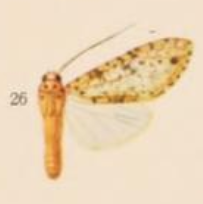
Curetis thetis, the Indian sunbeam, is a species of lycaenid or blue butterfly found in Indomalayan realm.

Pasiphila plinthina is a moth in the family Geometridae. It is endemic to New Zealand and is found in both the North, South and Stewart Islands. It is on the wing mainly from June until September with occasional observations up to December, and is attracted to light. This species is similar in appearance to P. sandycias but can be distinguished from it as P. plinthina has palpi that are longer and has more blurred forewing markings.

Ichneutica petrograpta is a moth of the family Noctuidae. This species is endemic to New Zealand where it is found in the southwest districts of the South Island, including Westland, Otago Lakes and Fiordland. It is very similar in appearance to I. mutans. It inhabits tussock and shrubland in the alpine to subalpine zones. Adults of I. petrograpta are on the wing from December to February and are attracted to sugar traps. The life history of this species is unknown as are the host species of its larvae.

Trigonistis anticlina is a species of moth in the family Noctuidae. It is endemic to New Zealand. Adults of this species inhabit dense native forest habitat in ravines.

Lophocampa atrimaculata is a moth of the family Erebidae. It was described by George Hampson in 1901. It is found in Costa Rica, Brazil, Bolivia and Peru.

Lophocampa endrolepia is a moth of the family Erebidae. It was described by Paul Dognin in 1908. It is found in Ecuador.
Bycombia verdugoensis is a moth in the subfamily Thyatirinae and only member of the genus Bycombia. It was described by Hill in 1927. It is found in North America, where it has been recorded from southern California.
Phalacra albilinea is a moth in the family Drepanidae. It was described by Warren in 1899. It is found in India.
Epipsestis castaneata is a moth in the family Drepanidae. It was described by Warren in 1915. It is found in Sikkim in India, Hunan in China and in Nepal and Vietnam.
Habrona caerulescens is a moth in the family Drepanidae. It is found in New Guinea, where it has been recorded only from the Star Mountains.
Nothoploca nigripunctata is a moth in the family Drepanidae. It is found in India, Vietnam, Korea, China and the Russian Far East.

Cotana rubrescens is a moth in the family Eupterotidae. It was described by Francis Walker in 1865. It is found in New Guinea.
Papuapterote styx is a moth in the family Eupterotidae. It was described by George Thomas Bethune-Baker in 1908. It is found in New Guinea.
Pseudojana pallidipennis is a moth in the family Eupterotidae. It was described by George Hampson in 1895. It is found in Myanmar and the north-eastern Himalayas.
Tantaliana nigristriata is a moth in the family Eupterotidae. It was described by Anthonie Johannes Theodorus Janse in 1915. It is found in South Africa, where it has been recorded from Mpumalanga and KwaZulu-Natal.
Phiala novemlineata is a moth in the family Eupterotidae. It was described by Per Olof Christopher Aurivillius in 1911. It is found in Uganda.
Papuapterote crenulata is a moth in the family Eupterotidae. It was described by James John Joicey and George Talbot in 1916. It is found on New Guinea.
Mecistoptera albisigna is a species of moth of the family Erebidae. It was described by George Hampson in 1912. It is found in southern India, Australia and on Fiji.
Aeolanthes ampelurga is a moth in the family Depressariidae. It was described by Edward Meyrick in 1925. It is found in northern India (Kumaon).

Asaphodes cosmodora is a species of moth in the family Geometridae. This species is endemic to New Zealand and has been observed in the South Island. The adults of this species are on the wing in January and February.







